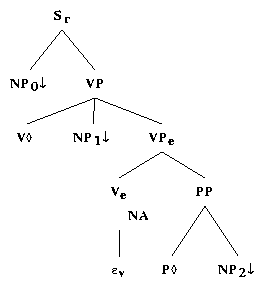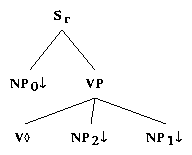

The indirect objects Beth Ann and refrigerator appear in these examples in the form of PP's. Within the set of ditransitive verbs there is a subset that also allow two NP's as in ((118)). As can be seen from ((118)) and ((119)) this two NP, or double-object, construction is grammatical for give but not for put.
The alternation between ((114)) and ((118)) is known as dative shift.10.1 In order to account for verbs with dative shift the English XTAG grammar includes structures for both variants in the two tree families Tnx0Vnx1Pnx2 and Tnx0Vnx2nx1. For an alternating verb such as give, there are two anchoring instances: give to selects Tnx0Vnx1Pnx2 and give selects Tnx0Vnx2nx1. The declarative trees for the shifted and non-shifted alternations are shown in Figure 10.1.
 |
0.5in |  |
| (a) | 0.5in | (b) |
The indexing of nodes in these two trees represents the fact that the semantic role of the indirect object (NP2) in Figure 10.1(a) is the same as that of the direct object (NP2) in Figure 10.1(b) (and vice versa). This use of indexing is consistent with our treatment of other constructions such as passive and ergative. Verbs that do not show this alternation and have only the NP PP structure (e.g. put) do not select the tree family Tnx0Vnx2nx1. Non-alternating verbs that select for particular prepositions take Tnx0Vnx1Pnx2 and those which take a wider range of prepositions take Tnx0Vnx1pnx2 (see Chapter 11 for more exposition on the XTAG treatment of these constructions). Other verbs such as ask allow only the NP NP structure as shown in ((120)) and ((121)). These verbs select only the tree family Tnx0Vnx2nx1.
There are other apparent cases of dative shift with for, such as the so called benefectives, ((122)) and ((123)), that we have taken to be structurally distinct from the cases with to.
[#!mccawley88!#] notes:
A ``for-dative'' expression in underlying structure is external to the V with which it is combined, in view of the fact that the latter behaves as a unit with regard to all relevant syntactic phenomena.In other words, the for PP's that appear to undergo dative shift are actually adjuncts, not complements. Examples ((124)) and ((125)) demonstrate that PP's with for are optional while ditransitive to PP's are not.
Other evidence in support of the view that for PP's are adjuncts comes from the do so test. Do so substitutes for an entire VP. This is illustrated in (1), where do so substitutes for ate a banana. The VP for which do so substitutes can exclude adjuncts (which are adjoined to a VP) as in (2), but not arguments, as shown in (3).
The dative to phrase acts like an argument according to this test (1), but the for phrase does not (2).
Since do so substitutes for an entire VP, the fact that ((132)) is grammatical indicates that the for PP is an adjunct (i.e., there exists a VP node lower than the for PP which do so can substitute for). Consequently, in the XTAG grammar the apparent dative shift with for PP's is treated as Tnx0Vnx2nx1 for the NP NP structure, and as a transitive plus an adjoined adjunct PP for the NP PP structure. To account for the ditransitive to PP's, the preposition to co-anchors the tree family Tnx0Vnx1Pnx2 with the alternating verb. [#!mccawley88!#] also notes that the to and for cases differ with respect to passivization; the indirect objects with to may be the subjects of corresponding passives, as seen in ((133))-((134)), while the alleged indirect objects with for cannot, as in sentences ((135))-((136)). Note that the passivisation examples are for NP NP structures of verbs that take to or for PP's.
However, we believe that this picture is inaccurate, and that the indirect objects in the for case are, in fact, allowed to be the subjects of passives, as in sentences ((137))-((138)). The apparent strangeness of sentence ((136)) is caused by interference from other interpretations of Clove was made dinner .